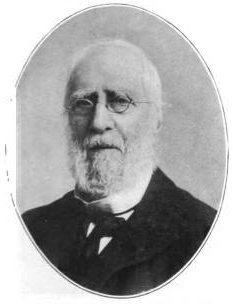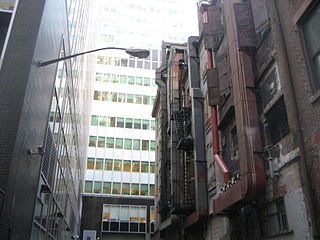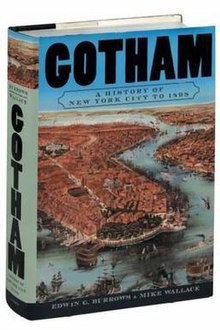
The written history of New York City began with the first European explorer, the Italian Giovanni da Verrazzano in 1524. European settlement began with the Dutch in 1608.

Mike Wallace is an American historian. He specializes in the history of New York City, and in the history and practice of "public history". In 1998 he co-authored Gotham: A History of New York City to 1898, which in 1999 won the Pulitzer Prize in History. In 2017, he published a successor volume, Greater Gotham: A History of New York City from 1898 to 1919. Wallace is a Distinguished Professor of History at John Jay College of Criminal Justice, and at the Graduate Center, CUNY.

The City of Greater New York was the term used by many politicians and scholars for the expanded City of New York created on January 1, 1898, by consolidating the existing City of New York with Brooklyn, western Queens County, and Staten Island. The section of the Bronx west of the Bronx River had been annexed to the City and County of New York in 1874 and was known as the Annexed District. The section of the Bronx east of the Bronx River had been annexed to the City and County of New York in 1895.

Leonard Walter Jerome was an American financier in Brooklyn, New York, and the maternal grandfather of Winston Churchill.
Edwin G. "Ted" Burrows was a Distinguished Professor of History at Brooklyn College. He is the co-author of the Pulitzer Prize-winning Gotham: A History of New York City to 1898 (1998), and author of Forgotten Patriots: The Untold Story of American Prisoners During the Revolutionary War, (2008), which won the 2009 Fraunces Tavern Museum Book Award.
The history of New York City (1855–1897) started with the inauguration in 1855 of Fernando Wood as the first mayor from Tammany Hall, an institution that dominated the city throughout this period. Reforms led to the New York City Police Riot of June 1857. There was chaos during the American Civil War, with major rioting in the New York Draft Riots. The Gilded Age brought about prosperity for the city's upper classes amid the further growth of a poor immigrant working class, as well as an increasing consolidation, both economic and municipal, of what would become the five boroughs in 1898.
Beginning July 7, 1834, New York City was torn by a huge antiabolitionist riot that lasted for nearly a week until it was put down by military force. "At times the rioters controlled whole sections of the city while they attacked the homes, businesses, and churches of abolitionist leaders and ransacked black neighborhoods."

The Astor House was a luxury hotel in New York City. Located on the corner of Broadway and Vesey Street in what is now the Civic Center and Tribeca neighborhoods of Lower Manhattan, it opened in 1836 and soon became the best-known hotel in America. Part of it was demolished in 1913; the rest in 1926.

Daniel Fawcett Tiemann was Mayor of New York City from 1858 to 1860. He was a founding trustee of the Cooper Union for the Advancement of Science and Art.

The United Charities Building, also known as United Charities Building Complex, is at 105 East 22nd Street or 287 Park Avenue South, in the Gramercy Park neighborhood of Manhattan, New York City, near the border of the Flatiron District. It was built in 1893 by John Stewart Kennedy, a wealthy banker, for the Charity Organization Society. It was designated a National Historic Landmark in 1991 for the role the Charity Organization Society played in promoting progressive social welfare policies, including the development of academic disciplines in that area.

Salmagundi; or The Whim-whams and Opinions of Launcelot Langstaff, Esq. & Others, commonly referred to as Salmagundi, was a 19th-century satirical periodical created and written by American writer Washington Irving, his oldest brother William, and James Kirke Paulding. The collaborators produced twenty issues at irregular intervals between January 24, 1807 and January 15, 1808.

Maiden Lane is an east–west street in the Financial District of the New York City, New York, United States borough of Manhattan. Its eastern end is at South Street, near the South Street Seaport, and its western end is at Broadway near the World Trade Center site, where it becomes Cortlandt Street.

University Place is a short north-south thoroughfare in the Greenwich Village neighborhood of Manhattan, New York City, United States, which runs from Washington Square Park in the south as a continuation of Washington Square East, taking the position of Madison Avenue uptown, and terminates at East 14th Street just southwest of Union Square. Although the roadway continues north of 14th Street as Union Square West, traffic on the two streets run in opposite directions, both feeding into 14th Street. Until the late 1990s, University Place was a two-way street. The street contains numerous cafes, shops, and restaurants, many of which cater to students at NYU and The New School.

The Jerome Mansion was a mansion on the corner of East 26th Street and Madison Avenue, across from Madison Square Park, in the modern NoMad neighborhood of Manhattan in New York City. It was the home of financier Leonard Jerome, one of the city's richest and most influential men in the middle- to late-19th century. It was built from 1859 to 1865 and demolished in 1967.
Peter Delanoy, who served from 1689 to 1691, was the first and only directly elected Mayor of New York City until 1834. Appointed mayors resumed in the wake of Leisler's Rebellion. He was succeeded by former Mayor John Lawrence.

Marketfield Street is a short one-way, one-block-long alleyway in the Financial District of Manhattan, New York City. The street begins as a southern branch of Beaver Street, then veers east and north, ending at Broad Street. Alternative past names include Exchange Street, Field Street, Fieldmarket Street, Oblique Road, and Petticoat Lane.

The Rotunda was a building that stood in City Hall Park in Lower Manhattan, New York City, from 1818 to 1870.
The New York Daily Sentinel, founded in 1830, was one of the first daily newspapers in the United States. It was founded by Benjamin Day, Willoughby Lynde, and William J. Stanley. Its publishers were Lynde, Stanley & Co., the Association of Working Men, and George H. Evans.

Konaande Kongh was a Lenape settlement of the Reckgawawanc located near what is now 98th Street and Park Avenue in East Harlem near Carnegie Hill. The settlement rested on what was once high ground, connected to the main path of Manhattan island by a branch that left the main path near 95th Street and crossed Fifth Avenue near 96th Street.














